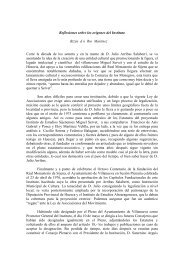New Page
New Page
New Page
You also want an ePaper? Increase the reach of your titles
YUMPU automatically turns print PDFs into web optimized ePapers that Google loves.
elections and the subsequent struggle between the two kings thus elected, both still holding a claim for the<br />
whole country. At that time the realm had two crowned kings, Ferdinand Hapsburg and John of Szapolya,<br />
but after the fall of Buda (1541) and the death of John of Szapolya (1540) the situation changed. The son<br />
of John of Szapolya, John Sigismund already made a point of setting up the centres of his power in the<br />
eastern half of the country, and was not crowned, either. He was only Johannes II. electus rex Hungariae,<br />
and giving up even this title in 1570, he was content to be Princeps Transylvaniae et Partium Hungariae.<br />
His successors held that title as well. Formally, the Principality of Transylvania was a vassal state of the<br />
Turks, its princes ruling with the approval of the Sultan, but the Turks did not interfere with its internal<br />
affairs and there was a possibility for a comparatively autonomous foreign policy as well.<br />
The directions of the development of the Reformation and that of Antitrinitarianism within it were<br />
significantly influenced by some of the important characteristics of the newly formed territory. What were<br />
these characteristics? First of all it will have to be emphasized that the Transylvanian Principality was<br />
ethnically extremely colourful. Three ethnic groups, the Hungarians, the Saxons and the Rumanians were<br />
approximately equally represented in the population which numbered about one million. Political life,<br />
however, was the field of action for three nations only, in the medieval sense of the word: the<br />
Hungarians (Magyars), that is the nobility of the region; the Szeklers (Székelys), an ethnically and<br />
linguistically somewhat distinct group of the Hungarians, holding on to its archaic internal structure and<br />
guarding the borders of the country, and finally the Saxons. Thus the ethnical and political groups did not<br />
correspond, and the Rumanians, who were mostly villeins, were -- like their Hungarian counterparts --<br />
excluded from political life. There were very few Rumanian noblemen, and those Rumanian who<br />
managed to get a title were soon integrated among the Hungarian nobility. There were significant<br />
differences between the regions included into the new state as well. While in Partium the landed<br />
aristocracy owned huge estates, the nobility of historical Transylvania had more modest properties. Also,<br />
while Partium had rich and energetic market towns (oppida), (Lippa, Simánd, Békés, Szatmár,<br />
Debrecen), those of historical Transylvania were much smaller. This will probably be explained by the<br />
fact that the rich Transylvanian Saxon towns (Szeben, Brassó, Medgyes, Segesvár, Beszterce) did their<br />
best to hinder the peasants' production for the market. Among the towns Kolozsvár must be separately<br />
mentioned. This town, situated at the crossing of important trade routes and developing extremely<br />
dynamically in the 15th and 16th centuries, became the intellectual centre of Transylvania. This was also<br />
helped by the fact that the rich Saxon and Hungarian burgesses of the town created balanced institutions<br />
that guaranteed equal rights for themselves and each other.<br />
The fact that the ruling princes of Transylvania were all members of the aristocracy of Partium<br />
meant that the weight of the central power was always secure in the life of the state. All this was reflected<br />
in the peaceful course of the Reformation and its being directed from the top. The case of the bishopric of<br />
Gyulafehérvár is one in point. The revenues and the palace of the bishopric, vacant since 1542 were<br />
secularized by Act of Diet so that the centres of the new political power could be established. The new<br />
principal power in the making thus vigorously contributed to the annihilation of the Catholic hierarchy<br />
with the logical consequence that the Transylvanian ruling Princes took over the secular provostship of<br />
the developing Protestant Churches. Although the new power of the prince was thus basically interested<br />
in supporting the ideas of the Reformation or at least deep-going ecclesiastical reforms, it would not have<br />
been enough in itself to guarantee the victory of Protestantism. This purpose, however, met the efforts of<br />
the various groups of Transylvanian society, inspired by the causes well-known all over Europe. This<br />
meeting resulted in the rather remarkable fact that in the territory of the Transylvanian Principality the<br />
Reformation was victorious peacefully, without major upheavals. That is what happened to Lutheranism,<br />
which came in gradually more and more intensive waves during the 1530s and 1540s, spreading first<br />
among the Saxons. They, by the way, have adhered to Lutheranism ever since. Lutheranism was but an<br />
episode among the Hungarian speaking population since in the 1550s more and more of them joined<br />
various Helvetian movements. In the beginning they followed Zwingli, then in the 1560s it was rather<br />
Bullinger and, to a lesser extent, Calvin whose influence could be felt. It seems that the boroughs of<br />
Partium were particularly ahead in the reception of Helvetian trends, but the majority of the nobility<br />
4







